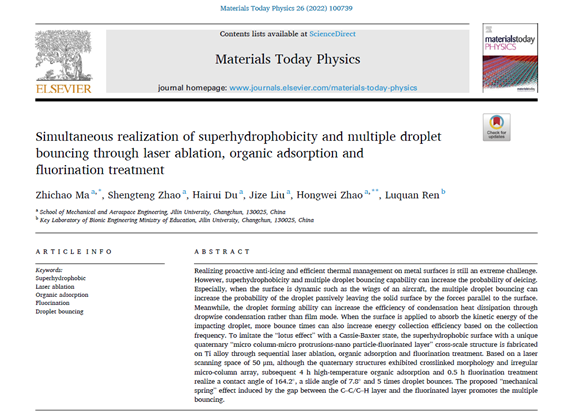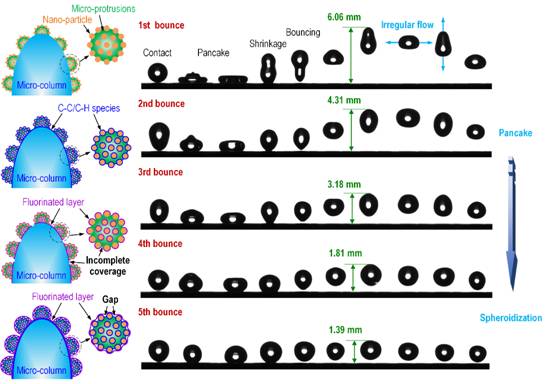It is still an arduous challenge to realize proactive anti-icing and efficient heat dissipation on metal surfaces. However, superhydrophobicity and multiple droplet bouncing capability will increase the possibility of deicing on the metal surface, especially for dynamic surfaces such as the wings of an aircraft. The multiple droplet bouncing will increase the probability of droplets leaving the metal surface under the action of horizontal force. At the same time, the spherical droplet forming ability can make the surface condensation mode drop condensation, which greatly improves the condensation heat transfer efficiency and avoids forming a liquid membrane on the surface to hinder condensation heat transfer. In addition, when the surface is used as an energy collection device to absorb the impact kinetic energy of falling droplets, more bouncing times can also improve the energy collection frequency, thus improving the energy collection efficiency.

Based on the “lotus effect” with a Cassie-Baxter state, a unique quaternary “micro-column-micro protrusions-nano particle-fluorinated layer” cross-scale structure was prepared on titanium alloy by laser ablation, organic adsorption and fluorination treatment. Micro-column array structure with cross-linking morphology was fabricated on the surface of titanium alloy by laser ablation, followed by high-temperature organic adsorption for 4 hours and fluorination treatment for 0.5 hours, achieving a contact angle of 164.2°, a slide angle of 7.8°,and five times of drops bouncing. With the increase in the number of droplets bouncing, the lateral spreading degree of droplets on the surface gradually decreases, and droplets tend to spheroidize. According to the measured surface chemical composition distribution, a “mechanical spring” composed of the gap between the organic adsorption layer and the fluoride layer and a “mechanical spring” effect to promote the multiple droplet bouncing are proposed.

The research was supported by the National Natural Science Foundation of China (51875241) and the Jilin Province Key R&D Plan Project (YDZJ202101ZYTS129). The correlative paper “Simultaneous realization of superhydrophobicity and multiple droplet bouncing through laser ablation, organic adsorption and fluorination treatment” was published in the well-known academic journalMaterials Today Physics. Professor Zhao Hongwei and Professor Ma Zhichao are co-corresponding authors of the paper, and Academician Ren Luquan from the Key Laboratory of Bionic Engineering, Ministry of Education, gave theoretical guidance. Professor Ma Zhichao is the first author of the paper.
Link to the paper:https://doi.org/10.1016/j.mtphys.2022.100739